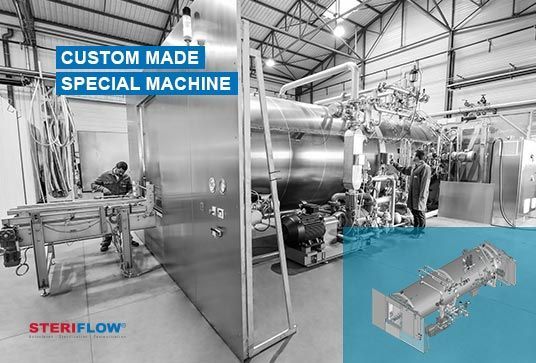Special machine manufacturing by Steriflow

Special machine manufacturing by Steriflow
For more than 45 years, Steriflow teams have been designing industrial sterilizers to effectively meet the demands of professionals in the pharmaceutical industry. Recently, the company was asked to sterilise syringes in blister packs. A custom-made industrial autoclave had to be designed.
Why sterilize syringes in blister packs?
Sterilization is essential to eliminate all kinds of microbiological contamination. The syringe allows the injection of a product into the patient’s body and must therefore be perfectly sterile. Indeed, this mode of administration bypasses our internal filters such as the intestine, stomach and kidneys (which are barriers to contamination). With the syringe we pass directly into the blood without any filtration and therefore risk is increased.
Why choose heat treatment for sterilization of blister syringes?
The blister pack has the particularity of being permeable to steam only. The heat treatment of a syringe in a blister pack is designed to allow steam to penetrate the packaging (unlike the sterilisation of a packaged food product which only heats up by thermal conduction through the wall). Under this principle, the steam used must be a so-called “clean” or “pure” steam.
How does the evacuation phase take place in a Steriflow industrial autoclave?
Evacuation is the action by which the air vacuum is created in the autoclave. This phase of the air-steam sterilization process has 5 main interests.- To purify the tank by eliminating air, considered as non-sterile : Vacuum at the beginning of the cycle- Eliminate air pockets within the steam which represent thermal barriers (air is a formidable insulator) : Vacuum at the beginning of the cycle- Purify the steam. In this way, the temperature can be regulated using the pure steam pressure. Such a steam pressure gives such a temperature with fantastic precision. This is a common principle in autoclaves for sterilizing surgical materials.- Dry the steam condensate. Steam releases its energy when it changes phase, i.e. when it condenses. This condensation must be eliminated because it is no more and no less than water that risks recontamination in the ambient air after sterilization.
Double side ventilation, an innovation developed by Steriflow
For the first time, Steriflow manufactured an industrial autoclave with a very large capacity. The vessel, with a 2-meter diameter and an about 10m length, required a specific technical design by integrating volute turbines versus propeller fans. Steriflow had to deal with several other issues by having to manage difficult operating conditions (internal pressure and vacuum) with a large volume to be stirred. The integration of flat sliding doors was complex to design for a pressure vessel considering its large dimensions.
